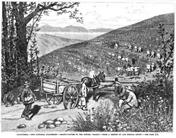Members' Recent Activities:
Welcome New Members
Actually it is “welcome back” to Alison Klairmont Lingo, who was previously a member of the Institute. Alison received her Ph.D. in history from UC Berkeley. Following her dissertation, “The Rise of Medical Practitioners in Sixteenth-Century France: The Case of Lyon and Montpellier,” she has written numerous articles for a variety of scholarly publications in the area of early modern medicine, including the topics of female medical practitioners, women’s health, midwifery, history of the body. In 2014 she joined the Department of History at UCB as research associate. Alison received the Josephine Roberts Award for the best scholarly edition in the field of early modern women and gender published in 2017: Louise Bourgeiois, Midwife to the Queen of France. She is currently exploring the debate about medical instruments and female midwives in France in the 17th and 18th centuries.
Institute president Elizabeth Thacker-Estrada recruited not only her colleague Patricia Southard but also her sister Alice Joanna Thacker, whom she introduces here. Patricia Southard has degrees in library & information science, gerontology, and psychology. Most recently, she worked at the Golden Gate National Recreation Area Park Archives in San Francisco. She has written and lectured on a variety of subjects including the history of libraries and archives, holocaust survivors, aging, women’s health, life transitions, and caregiving. She and Liz are researching and speaking on the relationship between US first ladies and women’s rights from colonial times to the present. They are planning a book based on their research.
Alice Joanna Thacker earned her doctorate in mental health at St. George’s Hospital Medical School, University of London. Now retired, she was a senior lecturer there and a visiting tutor at Oxford University. She has had a keen interest in the history that surrounds her life in the U.K. and has been active in a variety of projects. She and her husband Bruce volunteered as excavators at the Neolithic Ness of Brodgar, an archeological site on the main island of Orkney, Scotland. They live in London on the site of the William Morris and Arthur Liberty cloth mills, a perfect setting for her to demonstrate her talent in historical textiles: spinning, dyeing, and knitting period costumes. On the grounds of the nearby medieval Merton Priory, close to the Chapter House, Alice is planning and planting a monastic garden that will feature herbal remedies and dye plants. She is looking forward to becoming acquainted with fellow Institute members in both the US and the UK.
Elizabeth Thacker-Estrada was invited to serve on the Advisory Board of the Corresponce of Zachary Taylor and Millard Fillmore Project, an initiative of American University’s Center for Congressional and Presidential Studies. Three volumes of the presidents’ selected letters will be published. She also participated as a panelist in the program “In Sickness and in the White House: First Ladies’ Illnesses” hosted by the First Ladies Association for Research and Education (FLARE). Liz spoke about First Ladies Elizabeth Monroe, Letitia Tyler, Margaret Taylor, Abigail Fillmore, and Jane Pierce, and how, despite their ill health, they contributed to their husbands’ presidential administrations. Together with Patricia Southard, Liz presented “First Ladies and Women’s Rights, 1989-2009: A Century Ends, A Millennium Begins” at the Merced Branch of the San Francisco Public Library. They spoke about First Ladies Barbara Bush, Hillary Clinton, and Laura Bush.
At the annual meeting of Pro Ticino Nord California in March, Marilyn Geary read from her book Miners, Milkers & Merchants: From the Swiss-Italian Alps to the Golden Hills of Australia and California. She is also pleased to report that the book is being translated into Italian by the Swiss publisher Armando Dadò, to be released in August 2024.
Maria Sakovich was invited to speak to the Russophone Los Angeles Research Collective about the earliest days (1922-1931) in the development of the second Russian Orthodox church in California, Holy Virgin Mary in Los Angeles. “My presentation preparation brought me back to research I had undertaken in the 1990s when I had first become interested in the post-Bolshevik emigration in California. The box labeled "LA and the Golitsin family" and "Zoya Leonard" folders brought forth treasures I had forgotten about. Very satisfying to bring this material to light.”
Oliver Pollak’s article “Disbelief and Disability: Vivian Edwards’ Transcontinental Goat Cart Odyssey, 1907-1910” was published in the Spring 2024 issue of the Nebraska History Magazine. The subject had its first public debut as a Monthly Program in February 2023.
Jody (aka Judith) Offer provided an update to her work with the group of volunteers at the North Star House in Grass Valley for the staged reading of her “Scenes From the Life of Julia Morgan.” “All reports are positive,” she wrote. “One of the actors put together an excellent slide show of Julia’s work to run with the reading. Another has brought in lighting, and the sister of the director is a professional costumer and has taken over the costuming. The director keeps in touch and reports they seem to be having a very fun time. So I think it will be good for North Star in every way. And I get paid. Can it get any better?”
Sondra Herman contributed a chapter to Alva Myrdal: A Pioneer in Nuclear Disarmament (Springer Cham, 2022). “Solidarity Abroad: Alva Myrdal’s Campaign for the Developing Nations” is the only chapter in the book not about her work for nuclear disarmament. Sondra also reports that she has written and self-published a memoir, My People, Our Places. “Among the sketches are childhood and college friends, people I met and kept in touch with in the Netherlands, and Professor John Higham for whom I was a research assistant when I was a graduate student at Rutgers University; the memoir concludes with an extended piece on my husband, Frank Herman, who died in August 2021. I recommend memoir-writing both as a pastime and as a gift to your family, especially grown children. I would love to hear about members’ experience with memoir-writing.”
Again this year (April 20th) Peter Stansky hosted “A Company of Authors,” presentations by Stanford writers and editors about their recently published books. Leslie Friedman chaired one of the panels, “Taking Action.”
Pam Peirce has cobwritten an article on the Unitarian minister Rev. Dr. Frank Scott Cory Wicks (1868-1952), whose ministerial career took place primarily at All Souls Unitarian Church in Indianapolis, 1905-1937. The short biography will appear in the Journal of Unitarian Universalist Studies, Vol. XLVII(Summer 2024). Later, a shortened version of the article will appear in the online Dictionary of Unitarian Universalist Biography (uudb.org).
Nathan Foxton’s solo exhibit of his art opens at Moth Belly Gallery (912 Larkin Street, San Francisco) on June 6th and up through June 29th.
In connection with the publication of her book (see below) Bonnie Portnoy “is celebrating two solo exhibitions. A four-month exhibit just concluded on March 30 at the Museum of Sonoma County—‘Tilden Daken: The Art of Adventure.’ A second exhibition of the same title, also curated by Museum of Sonoma County, showcases this spring in the House of Happy Walls Museum at Jack London State Historic Park, from April 19 through June 23. ‘My mother is looking down with tremendous pride—Tilden and Jack will be together again on Beauty Ranch.’”
Members’ New Books
Celeste MacLeod: After years of hard work and dedication, I am pleased to announce the release of my new book,
A Woman of Unbearable Opinions: Fanny Trollope, Dynamic Satirist, now
available on Amazon.*
Americans were furious in 1832 when English visitor Fanny Trollope’s satirical travel book Domestic Manners of the Americans made fun of their insistence that they lived in the most exceptional country in recorded human history. But when she went back to England and wrote novels advocating for social justice, British reviewers accused her of being a dangerous radical. And when she wrote novels about English women’s experiences in oppressive marriages, reviewers excoriated these books as crude and vulgar. By examining Trollope’s life and the controversies generated by her writing, A Woman of Unbearable Opinions invites readers to consider the enduring relevance of these issues and encourages reflection and discussion in the context of modern society. "Fanny Trollope’s writings remind us that many of the challenges and debates she confronted in the 19th century are still very much a part of our contemporary world. The book delves into the fascinating life of a dynamic woman whom I greatly admire, and I believe it will resonate with readers of varied backgrounds and interests. I would be honored if you would consider reading it and sharing your thoughts with me."
Bonnie Portnoy: My fully illustrated biography The Man Beneath the Paint: California Impressionist Tilden Daken has just been published. Institute member Rose Marie Cleese performed the final honing of my manuscript with great aplomb. About fifteen years ago, I joined the Institute and its Writers Group after launching my legacy project on artist Tilden Daken (1876-1935). Famous in his day, he was the grandfather I never knew. My 25-year research and writing journey began in 1999 while my mother was still living, the older of Daken’s two daughters, both born in Glen Ellen. I grew up hearing the stories from my mother of her father’s friendship with Jack London. Raised in Sacramento, Tilden Daken began to paint en plein air at the age of six, studied classical music, and mined for gold with his father in the Sierra Nevada foothills. Today he is considered one of the most prolific and adventurous painters in the American West. Historians claim he painted more than 4,000 works—landscapes in every California state park and national park in the West—from the redwood forests, to the High Sierra, to beneath the Pacific in a custom-built diving bell. The covers feature a beautiful tribute to Tilden’s legacy by Armando Quintero, director of California State Parks and a blurb by Nancy Dustin Wall Moure, the noted California art historian. The foreword is written by Matt Leffert, executive director of Jack London Park Partners. The book will be available in selected indie bookstores and museum shops, and online through the Nevada Museum of Art bookstore.
Mary Judith Robinson announced the publication of her Memoir of a Reluctant Debutante or When in Danger, Breathe. From the back cover: “She has had a career as a journalist, editorial writer, legislative assistant in the US Senate and House of Representatives. Adventures included exploring mind-expanding drugs that took her on unique journeys. Lessons learned were that ‘All things pass—a sunrise does not last all morning.’ She is the author of ten published biographies [five of which formed the basis of her Monthly Presentation in February–see page 4]. Her ancestors were colonial settlers of New England and New York, pioneers to the Midwest who settled Kansas City, Missouri, Lawrence and Wichita, Kansas, a founding professor of the University of Kansas, and the first Episcopal Bishop of California. The memoir can be ordered from Judith: Telegraph Hill Press, 562 B Lombard Street, San Francisco, CA 94133-7057.
Members: Please submit news of your history-related publications, lectures, awards, research finds, etc. to info@instituteforhistoricalstudy.org.





